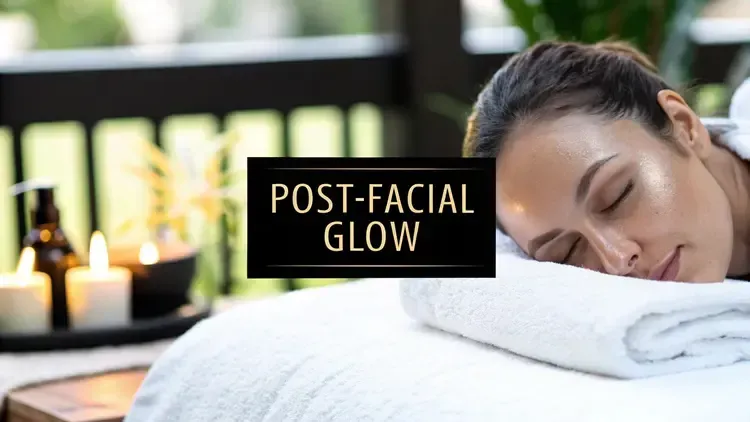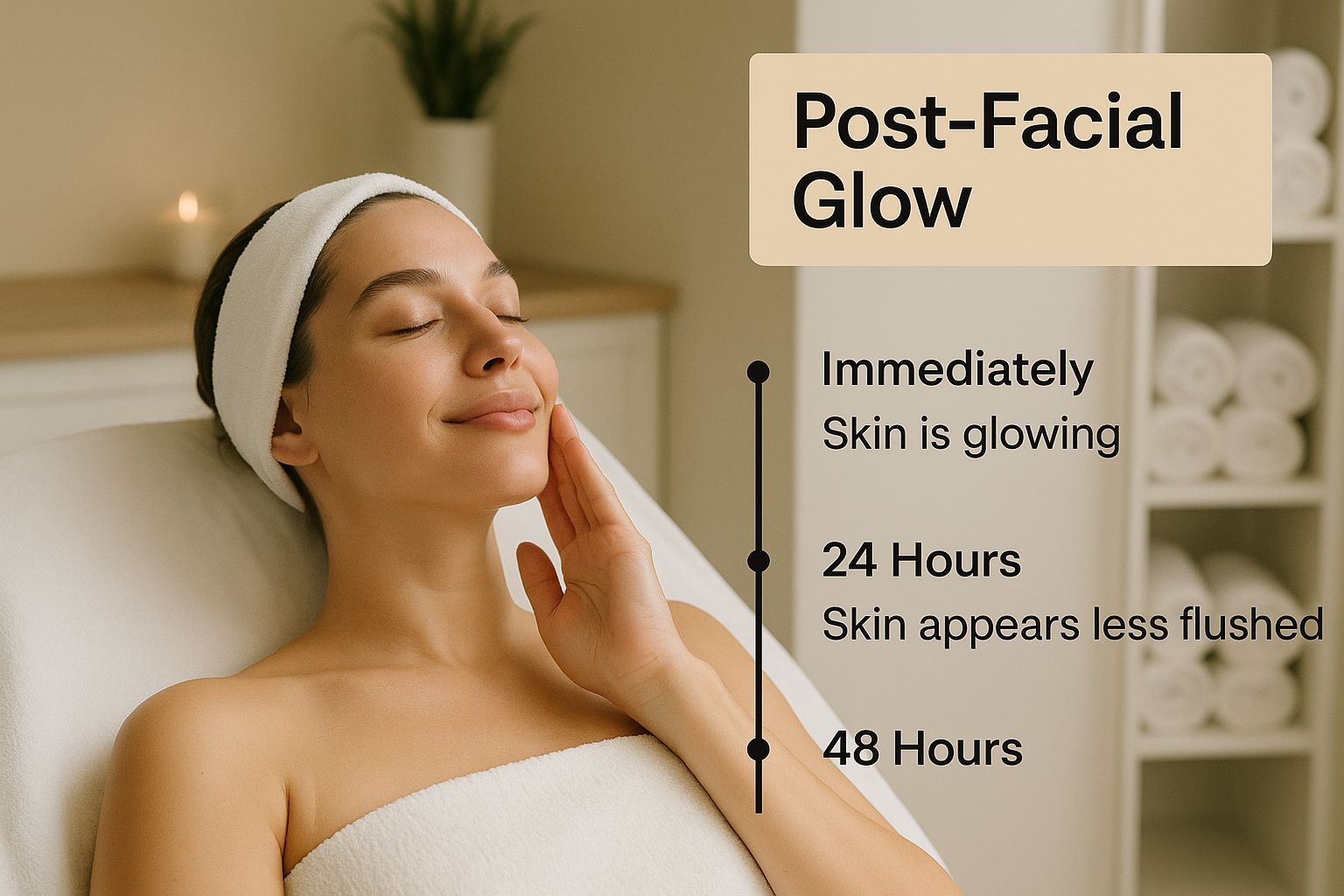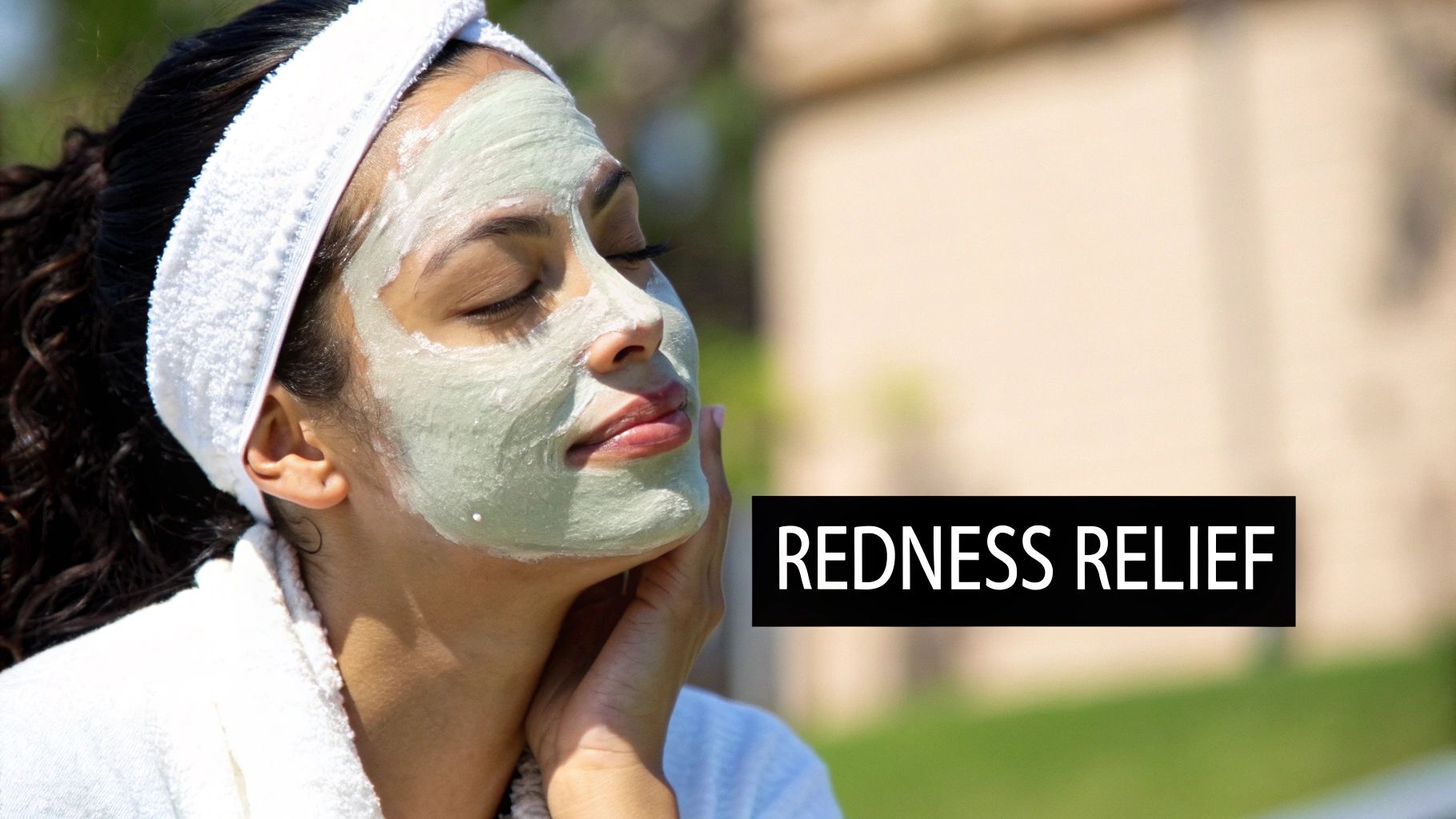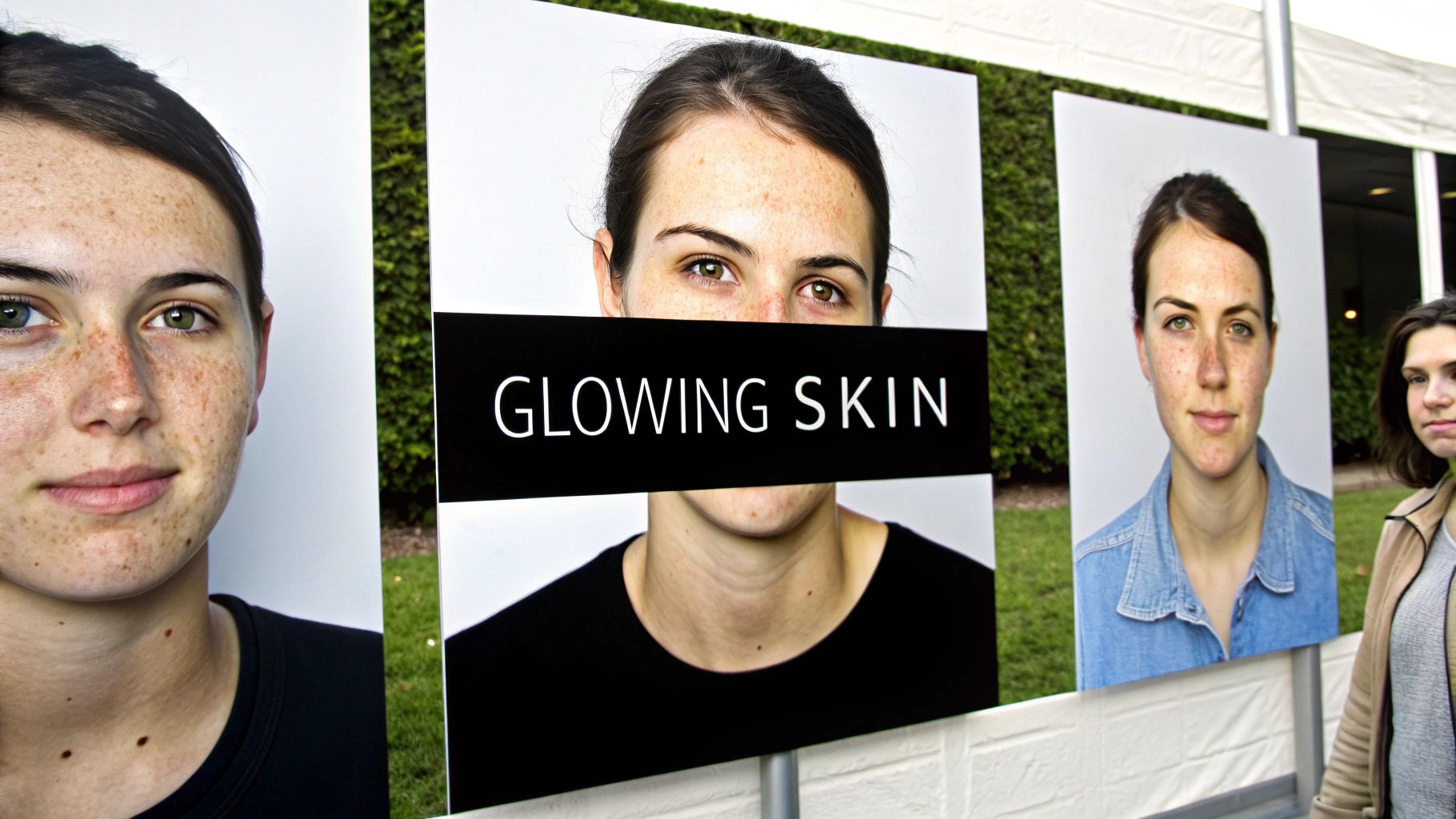
What to Expect After a Facial A Complete Guide
You've just walked out of your facial, and your skin feels squeaky clean and incredibly smooth. But when you catch your reflection, you might see a bit more pink than you expected. Don't panic! A little bit of redness or blotchiness is completely normal—in fact, it’s a good sign.
That temporary flush is your skin’s way of saying, "Wow, that was a workout!" The treatment has revved up your circulation and kicked off a deep cleansing process. Think of it as the immediate, visible proof that your skin is already on its way to looking its best. This initial sensitivity usually calms down within just a few hours.
What to Expect in the First 24 Hours
That post-facial glow is real, but understanding the journey your skin takes over the next day is what truly helps you appreciate the long-term benefits. The first 24 hours are all about recovery and response.

This image perfectly captures that fresh, radiant look that defines a great facial. It's the starting line for a short but important recovery phase that leads to even better results.
Understanding Initial Reactions
It’s perfectly normal for your skin to look a little "worked on" right after your appointment. The most common reactions are short-lived and signal that the facial was effective in boosting blood flow and encouraging cell turnover.
Since treatments often involve exfoliation, peels, or extractions to clear out pores and slough off dead skin, a certain level of response is to be expected. Research indicates that around 60-70% of people experience some minor redness or slight irritation immediately after a session. This is just a standard part of the skin renewal process. You can dig deeper into facial treatment market trends for more data on this.
Your skin might feel slightly tender or appear flushed, but this is the start of the renewal process. This increased circulation brings oxygen and nutrients to your skin cells, which is exactly what you want for a long-term healthy glow.
What to Look For Right Away
Within the first few hours, you'll probably notice a few distinct changes as your skin starts to settle. Knowing what's coming helps you feel confident that everything is going according to plan.
To help you know what to expect, I've put together a quick timeline of the most common reactions you might see in the first day or two.
Post-Facial Skin Reaction Timeline
Reaction What It Looks/Feels Like Typical Duration Healthy Glow Luminous, dewy, and radiant skin. 24-48 hours Temporary Redness A pinkish or slightly flushed appearance. 1-4 hours Plumpness Skin feels supple, hydrated, and firm to the touch. 24-72 hours Slight Tenderness A mild sensitivity, especially in extracted areas. 12-24 hours
This table gives you a general idea, but remember, everyone's skin is different! The key takeaway is that these initial effects are the first signs that your investment is paying off. They pave the way for the more significant, lasting results that will emerge as your skin fully regenerates over the next few days.
Your Skin's Journey: The First 72 Hours
The first 72 hours after your facial are when the magic really settles in. This is the most crucial window for healing and locking in all the benefits of your treatment. Think of it as a delicate recovery period where your skin is working overtime to regenerate.
Knowing what’s normal—and what isn't—will help you feel confident as you see the changes unfold. Your skin has a predictable recovery path, and understanding it day by day is the key to getting that incredible, long-lasting glow.
Day 1: The "Hands-Off" Calm-Down
Right after your treatment, your skin's top priority is to simply calm down. It's just had an intense deep-clean and workout, so now it's all about gentle protection. You'll likely leave the spa with a beautiful glow, but don't be surprised to see a bit of redness or feel some tenderness, especially if you had any extractions.
The number one rule for day one? Hands off. Your pores are wide open and highly susceptible to bacteria. Touching your face is the fastest way to invite irritation or a breakout, so let those powerful professional products your esthetician applied do their job in peace.
Day 2: The Glow-Up (and a Little Purging)
By day two, most of that initial redness has usually faded, making way for some serious radiance. Your skin will likely feel incredibly smooth and plump as it soaks up all the hydrating goodness from your treatment. This is often when you catch a glimpse of that "wow" factor you were hoping for.
Now, don't panic if a new blemish decides to make an appearance. This is a totally normal and even positive sign called skin purging.
Think of it this way: your facial essentially hit the fast-forward button on your skin’s exfoliation process. It pushed any congestion that was already brewing deep below the surface up and out. This isn't a new breakout; it's an old one making a quick exit.
Day 3: Settling In and Smoothing Out
Welcome to day three, when your skin really starts to hit its peak. Any minor purging from yesterday should be on its way out, and your skin’s texture will feel noticeably more refined. You’ll see a more even, vibrant tone—this is your complexion settling into its best self.
To keep things on the right track and protect your investment, just follow a few simple rules:
Do keep it simple. A gentle cleanser, a basic moisturizer, and—most importantly—a broad-spectrum SPF 30 or higher are your best friends.
Don't reach for the heavy hitters. Put away your retinoids, exfoliating acids (like glycolic or salicylic acid), and facial scrubs for at least 3-5 days. Your skin is too sensitive for that right now.
Do hydrate from the inside out. Drinking plenty of water gives your skin the fuel it needs to repair itself beautifully.
Don't bring the heat. Skip the saunas, steam rooms, and super hot showers, as they can trigger inflammation and undo all that calming work.
How Your Facial Type Shapes Your Aftercare
It's a common mistake to think all facials leave your skin looking and feeling the same way immediately after. That’s a bit like expecting a gentle yoga class and a high-intensity workout to have the same effect on your muscles. Each facial is built to achieve a specific goal, so what to expect after a facial is completely tied to the service you just had. The intensity, the techniques used, and the products applied all shape your skin's immediate reaction and your aftercare plan.

Knowing what's normal for your specific treatment helps you navigate the healing process with confidence instead of worry. A gentle, calming facial will leave you with a different immediate result than an intensive chemical peel, and that’s perfectly okay.
Decoding Your Post-Treatment Experience
Let's break down some of the most common facials and what you can realistically anticipate in the hours and days that follow. When you can match your experience to the right category, you get peace of mind and the power to care for your skin the right way.
For example, a hydrating facial is all about drenching your skin in moisture. The goal here is instant gratification. You should walk out with a dewy, plump, and radiant complexion that looks visibly quenched. There's virtually no downtime, just an immediate healthy glow.
On the other hand, a treatment like microdermabrasion is a physical, mechanical exfoliation. It uses a special tool to buff away the top layer of dead skin cells. This process often leaves the skin with a temporary pinkish glow and a slightly "scratchy" or "sandpaper" texture for a day or two. Don't worry—this is the precursor to revealing much smoother, brighter skin underneath.
A facial’s purpose dictates its immediate aftermath. A treatment designed for deep exfoliation will naturally require more recovery time than one focused purely on hydration. Understanding this distinction is the first step in successful aftercare.
Expected Reactions by Facial Type
To give you a clearer picture, this table compares some of the most popular facials, their goals, and what you can typically expect afterward. This is a great cheat sheet for quickly figuring out if what you're seeing in the mirror is normal for your situation.
Facial Type Primary Goal Common Immediate Effects Typical Downtime Hydrating Facial Boost moisture and radiance. Dewy, plump, and glowing skin. None Microdermabrasion Improve texture and tone. Mild redness, slight roughness. 24-48 hours Chemical Peel Resurface skin, treat acne or pigment. Redness, peeling, dryness (varies by peel strength). 3-7+ days Acne Facial Clear congestion and reduce inflammation. Redness, temporary marks from extractions, potential purging. 24-72 hours
As you can see, the experiences vary widely. An acne facial, especially one with extractions, will likely leave you with some localized redness. You might even see a few new blemishes pop up in the next day or two. This is called purging—it's a good sign that the treatment is clearing out deep, underlying congestion.
For chemical peels, the reaction is the treatment. A light peel might just cause some mild flaking, but a deeper one will involve more significant shedding and peeling as the old skin makes way for new. When you know this ahead of time, you can see the peeling not as a scary side effect, but as a sign that the facial is working exactly as it should.
Your Essential Post-Facial Skincare Routine
Think of your facial as a professional reset for your skin. Your esthetician has done the heavy lifting, clearing the way for a fresh, glowing complexion. But what you do in the days that follow is just as crucial—it’s what protects that beautiful work and makes the results last.
Your skin has just received a deep, professional-level exfoliation. This is fantastic, but it also means your skin is temporarily more sensitive and a little vulnerable. Your main job now is to soothe, hydrate, and shield it.
The Pillars of Post-Facial Care
For the first 24-72 hours, simplicity is your best strategy. This isn't the time to break out your most potent products or try something new. You need to strip your routine back to the bare, gentle essentials.
Gentle Cleanser: Wash with a mild, pH-balanced, soap-free cleanser and lukewarm water. Hot water is a no-go, as it can be irritating and strip your skin. Gently pat your face dry with a clean, soft towel—absolutely no rubbing.
Hydrating Serum: A hyaluronic acid serum is your post-facial hero. It pulls moisture deep into the skin, keeping it calm, plump, and hydrated without clogging those freshly cleared pores.
Simple Moisturizer: Follow up with a basic, fragrance-free moisturizer. Its job is to lock in all that hydration and support your skin's natural protective barrier as it recovers.
Broad-Spectrum SPF: This is completely non-negotiable. Freshly exfoliated skin is highly susceptible to sun damage. Every single morning, you need to apply a broad-spectrum sunscreen of at least SPF 30. This is your best defense against new sunspots and UV damage that could undo your facial’s benefits.
What to Strictly Avoid
Knowing what not to do is just as important as knowing what to do. Using the wrong products too soon can easily lead to irritation and redness, effectively erasing the progress you just made.
For at least 3-5 days after your facial, press pause on all "active" skincare ingredients. This means no retinoids (like retinol), exfoliating acids (glycolic, lactic, salicylic), vitamin C serums, or any kind of physical scrub or cleansing brush.
You'll also want to skip makeup for at least 24 hours. Your pores are open and need time to breathe. Clogging them with foundation right away is a recipe for congestion and breakouts. If you've had a more intensive treatment, our guide on microneedling aftercare instructions that actually work provides more specific healing advice.
It's no surprise that people are investing more in their skin, with the global facial market expected to hit USD 2.31 billion by 2033. Following the right aftercare plan is how you ensure that your investment truly pays off. You can discover more about the growing facial treatment market and see how consumer habits are shifting.
Is It Skin Purging or a Bad Reaction?
Waking up with new blemishes after a facial can be so disheartening. You’re left wondering if the treatment actually made things worse. But here's something experienced estheticians know: breakouts after a facial aren't always a bad sign. The trick is understanding the difference between skin purging and a true-blue negative reaction.

Think of purging as a deep spring cleaning for your pores. The facial just hit the fast-forward button on your skin's renewal process. All that underlying gunk—the micro-comedones and clogged pores that were already brewing under the surface—gets pushed out all at once. It’s a good sign, really. It means the treatment is working and clearing the way for healthier skin.
Telling the Difference Between Purging and a Reaction
So, how can you tell if your skin is just "cleaning house" or genuinely unhappy? It mostly comes down to the location and lifespan of the blemishes.
Purging almost always happens in your usual breakout zones—think your chin, forehead, or nose. These spots also tend to show up and clear out much faster than your typical, stubborn pimple.
A negative reaction, on the other hand, feels and looks different. It’s more than just a pimple.
Here’s a quick guide to tell them apart:
Skin Purging: You’ll see small, inflamed bumps or whiteheads pop up in your usual problem areas. They should resolve within about a week as your skin finds its new balance.
Adverse Reaction: This is more likely to involve itchiness, a rash, hives, or breakouts in places you never get them. The irritation might feel like it's burning or just won't go away.
A good rule of thumb is that purging speeds up what was already there, while a bad reaction introduces a brand-new problem. If you’re dealing with intense itching or a rash that’s spreading, it's time to call your esthetician.
Given that about 85% of young adults struggle with at least minor acne, it makes sense why acne-focused facials are so popular—and why this whole purging conversation is so important.
When to Seek Advice
If you even suspect it's a negative reaction, don't just wait and see. Reach out to your skincare professional right away. They can go over the products they used and give you specific advice.
For more advanced treatments like collagen induction therapy, knowing what to expect is even more critical. If you're curious about that, our guide on microneedling before and after results can offer some valuable insight. At the end of the day, it's about trusting the process but also listening to your skin and speaking up when something feels off.
Answering Your Post-Facial Questions
Even with a perfect facial and a clear aftercare plan, questions are bound to pop up. It's completely normal! Knowing what to expect and how to handle these common situations will help you feel confident as your skin heals and reveals its new glow.
Let's walk through the most frequent questions I hear from clients, so you know exactly what to do every step of the way.
When Can I Wash My Face?
This is the number one question, and for good reason. After your treatment, your skin is coated in a beautiful cocktail of potent serums and moisturizers. You want to give them as much time as possible to sink in and work their magic.
My best advice? Hold off until your usual nighttime routine. If you had an evening facial, it's often best to just sleep on it and wash your face in the morning. When you do wash, how you do it is just as critical as when.
Gentle cleanser only: Reach for a mild, pH-balanced cleanser. Now is not the time for anything with harsh soaps, exfoliants, or acids.
Use lukewarm water: Hot water can strip your skin and worsen any temporary redness. Cool or lukewarm is the way to go.
Pat, don't rub: Gently pat your skin dry with a clean, soft towel. Rubbing can cause unnecessary irritation. Let it air dry the rest of the way.
Stick with this gentle approach for at least 24-48 hours to give your skin a calm, peaceful environment to recover.
Can I Wear Makeup After a Facial?
In a perfect world, I'd ask you to keep your skin completely bare for a full 24 hours. Your pores are clean, open, and more receptive—but this also means they are more vulnerable to being clogged by makeup.
Of course, life happens. If you absolutely can't go without makeup, please try to wait at least 6-8 hours. And when you do apply it, be strategic.
Mineral makeup is your best friend. These formulas are generally lighter and less likely to cause congestion than heavy liquid foundations. Just as important: always use clean brushes or sponges to avoid introducing bacteria to your freshly treated skin.
When Will I See the Final Results?
You'll definitely leave your facial with an immediate, dewy glow. That's the instant gratification part! But the real magic happens a few days later.
The sweet spot for seeing the full, settled results is typically between days 3 and 7.
By this point, any lingering pinkness or minor purging has cleared up. Your skin cells have started their renewal process, and all those nourishing ingredients have been fully put to work. This is when you'll look in the mirror and see that smoother texture and vibrant, healthy radiance we're aiming for.
For more intensive treatments like chemical peels, the "wow" moment can be even more pronounced. You can see some incredible examples in our guide to chemical peel before and after results.
What if I Have a Bad Reaction?
First, it’s crucial to know the difference between a normal response and a true adverse reaction. A bit of temporary redness or even a small "purge" pimple can be part of the process. What we're on the lookout for are signs of distress.
You should take action if you experience:
Intense, persistent itching that doesn't subside
A burning feeling
Noticeable swelling or puffiness
A rash or hives
If you see any of these signs, your first call should be to the esthetician who performed your facial. We keep detailed records of every product used and are in the best position to give you specific advice. We can help figure out if it's an allergic reaction or a simple sensitivity.
If the reaction feels severe, is getting worse, or you can’t get ahold of your provider, don't hesitate to check in with a dermatologist. In the meantime, treat your skin like delicate fabric: rinse gently with cool water and apply only the most basic, fragrance-free moisturizer you have. Stop using all other products until you get professional guidance.
At Olive Skin Therapy, we believe expert care continues long after you leave our studio. By understanding your skin's needs and providing personalized aftercare advice, we empower you to achieve and maintain healthy, radiant skin. Book your customized treatment with us today.
